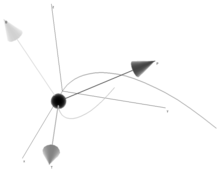
A | B | C | D | E | F | G | H | CH | I | J | K | L | M | N | O | P | Q | R | S | T | U | V | W | X | Y | Z | 0 | 1 | 2 | 3 | 4 | 5 | 6 | 7 | 8 | 9
Differential geometry of curves is the branch of geometry that deals with smooth curves in the plane and the Euclidean space by methods of differential and integral calculus.
Many specific curves have been thoroughly investigated using the synthetic approach. Differential geometry takes another path: curves are represented in a parametrized form, and their geometric properties and various quantities associated with them, such as the curvature and the arc length, are expressed via derivatives and integrals using vector calculus. One of the most important tools used to analyze a curve is the Frenet frame, a moving frame that provides a coordinate system at each point of the curve that is "best adapted" to the curve near that point.
The theory of curves is much simpler and narrower in scope than the theory of surfaces and its higher-dimensional generalizations because a regular curve in a Euclidean space has no intrinsic geometry. Any regular curve may be parametrized by the arc length (the natural parametrization). From the point of view of a theoretical point particle on the curve that does not know anything about the ambient space, all curves would appear the same. Different space curves are only distinguished by how they bend and twist. Quantitatively, this is measured by the differential-geometric invariants called the curvature and the torsion of a curve. The fundamental theorem of curves asserts that the knowledge of these invariants completely determines the curve.
Definitions
A parametric Cr-curve or a Cr-parametrization is a vector-valued function
The parametric curve is simple if
The curve γ is regular of order m (where m ≤ r) if, for every t ∈ I,
Re-parametrization and equivalence relation
Given the image of a parametric curve, there are several different parametrizations of the parametric curve. Differential geometry aims to describe the properties of parametric curves that are invariant under certain reparametrizations. A suitable equivalence relation on the set of all parametric curves must be defined. The differential-geometric properties of a parametric curve (such as its length, its Frenet frame, and its generalized curvature) are invariant under reparametrization and therefore properties of the equivalence class itself. The equivalence classes are called Cr-curves and are central objects studied in the differential geometry of curves.
Two parametric Cr-curves, and , are said to be equivalent if and only if there exists a bijective Cr-map φ : I1 → I2 such that
Re-parametrization defines an equivalence relation on the set of all parametric Cr-curves of class Cr. The equivalence class of this relation simply a Cr-curve.
An even finer equivalence relation of oriented parametric Cr-curves can be defined by requiring φ to satisfy φ′(t) > 0.
Equivalent parametric Cr-curves have the same image, and equivalent oriented parametric Cr-curves even traverse the image in the same direction.
Length and natural parametrization
The length l of a parametric C1-curve is defined as
For each regular parametric Cr-curve , where r ≥ 1, the function is defined
This parametrization is preferred because the natural parameter s(t) traverses the image of γ at unit speed, so that
For a given parametric curve γ, the natural parametrization is unique up to a shift of parameter.
The quantity
Frenet frame

A Frenet frame is a moving reference frame of n orthonormal vectors ei(t) which are used to describe a curve locally at each point γ(t). It is the main tool in the differential geometric treatment of curves because it is far easier and more natural to describe local properties (e.g. curvature, torsion) in terms of a local reference system than using a global one such as Euclidean coordinates.
Given a Cn + 1-curve γ in
Antropológia
Aplikované vedy
Bibliometria
Dejiny vedy
Encyklopédie
Filozofia vedy
Forenzné vedy
Humanitné vedy
Knižničná veda
Kryogenika
Kryptológia
Kulturológia
Literárna veda
Medzidisciplinárne oblasti
Metódy kvantitatívnej analýzy
Metavedy
Metodika
Text je dostupný za podmienok Creative
Commons Attribution/Share-Alike License 3.0 Unported; prípadne za ďalších
podmienok.
Podrobnejšie informácie nájdete na stránke Podmienky
použitia.
www.astronomia.sk | www.biologia.sk | www.botanika.sk | www.dejiny.sk | www.economy.sk | www.elektrotechnika.sk | www.estetika.sk | www.farmakologia.sk | www.filozofia.sk | Fyzika | www.futurologia.sk | www.genetika.sk | www.chemia.sk | www.lingvistika.sk | www.politologia.sk | www.psychologia.sk | www.sexuologia.sk | www.sociologia.sk | www.veda.sk I www.zoologia.sk
















